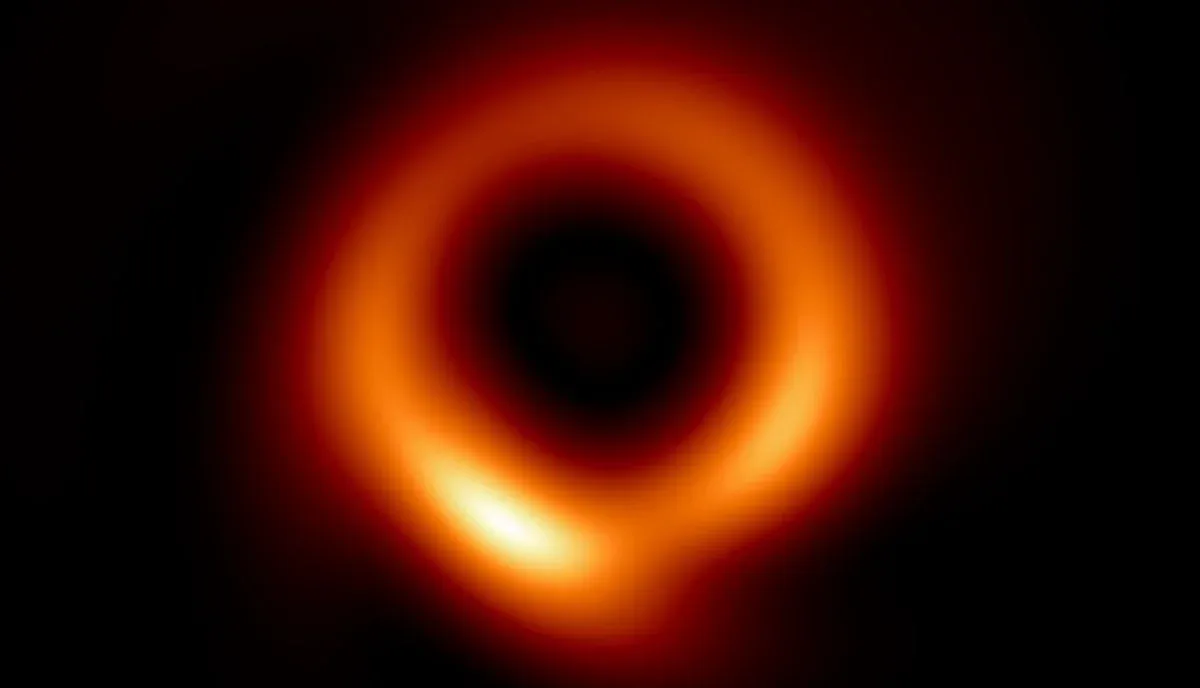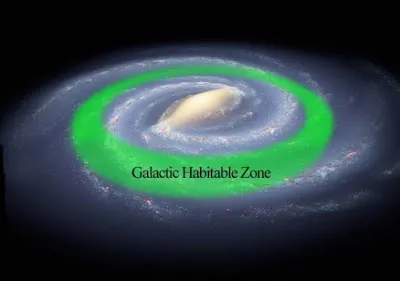Galaxy : Classification | Formation | Evolution | Stars | Possibility of Life
What's In This Article...
When we glare at the beautiful night sky, our eyes encounter countless stars twinkling and charming our eyes.
In the past of human civilization, when we were not much developed in the scope of astronomy, our ancestors wondered what were those tiny twinkling objects hanging in the sky ? Various people proposed different types of hypotheses, some call them as fairies, others call them spirits of their ancestors or gods and whatsoever. But at that time they didn't know that our sun is also a star like all other objects hanging in the night sky.
Now let's continue to our main topic of the day i.e., "what is a galaxy?"
Galaxy
Well, a galaxy is a group of massive numbers of various types of stars and other celestial bodies of different age groups. Most of all the galaxies are like wide circular ringed strips of stars curved and seem like going to the center. Astronomers find that in almost all the galaxies, there is a supermassive black hole at the center of the galaxy and all the stars (billions and trillions in number or even more) and other celestial bodies revolve around the supermassive black hole. This supermassive black hole is like the king or a dictator of the galaxy.
There are lots of other strange phenomena that happen at galaxy levels such as the merging of galaxies, star formation and deformation at the near center of the galaxy, effect on supermassive black holes on the entire galaxy and life and danger zone in a galaxy. So don't slack off and get ready to read with joy and concentration. Develop reading skills.
As for ours, we are in the Milky Way Galaxy (circular shaped or spherical shaped). We named the Supermassive Black Hole of our galaxy as Sagittarius A*.
Our Galaxy's Name: Milky Way.
Supermassive Black Hole Name: Sagittarius A*
Classification Of Galaxies
There are various kinds of galaxies in terms of shape and size. Some of the few standard cases are written below:
- Elliptical Shape Galaxy.
- Circular or Spiral Shaped Galaxy.
- Distorted or Irregular Shape Galaxy.
Elliptical Shape Galaxy
These galaxies are elongated circular shaped or elliptical shape, thus its name is elliptical shape galaxy.
Spiral Shape Galaxy
This type of galaxy looks perfect or nearly circular in shape, thus its name is spiral shaped galaxy.
Irregular Shape Galaxy
The structure of these types of galaxies is not likely to be uniform. They are neither circular nor nearly oval and thus named Irregular.
There are other deeper categories under those three such as barred spiral shaped galaxies (actually our Milky Way galaxy falls under this category).
Formation Of Galaxies
There were many theories proposed back when we don't know much about galaxies. But with the advanced technology and application of high resolution telescopes, we are able to get many great images and records with which astronomers and astrophysicists can propose a much clearer theory which is widely accepted. One is "Bottom Up Theory" and the other is "Top Down Theory".
According to the bottom up theory, it is related to the birth of the universe or the early state of the universe and other factors (which we will discuss later). It says that after the birth of the universe (that is after the big bang), gas clouds that mainly contain 'Hydrogen' atoms and molecules spread in all directions as the universe expanded.
It is said that there is something called 'dark matter' which is hugely responsible for the designation of our universe (meaning this so-called 'dark matter' plays a vital role in separating or channelizing the gas clouds in our early universe) and this 'dark matter' is spread throughout our universe. I need to tell you that there is not a lot of data and information about this thing and scientists and researchers are currently doing their work to know this mythical thing deeply. Well actually it is not a myth, it is true, here is a NASA report (details about dark matter).
As the universe expanded, these gas clouds also expanded and scientists concluded that these gas clouds then accumulated in various regions of space due to gravity and gave birth to primordial stars. These massive stars then ended as black holes and black holes got bigger as the time passed and evolved into supermassive black holes. These Supermassive black holes have very strong gravitational pull.
Since supermassive black holes have the strongest gravitational pull, all the stars revolve around this giant monster. Dark Matter also plays an important role in designing the galaxies and their structures throughout the universe.
One interesting thing between all this complex stuff is that all the stars that you see in the night sky are the stars of our Milky Way galaxy only. So what do you think about the whole universe?
From this very moment, the formation as well as evolution of galaxies started and this complex web throughout the cosmic ocean gets even deeper.
Gist
- birth of the universe (big bang) and expansion of gas and dust clouds.
- accumulation of gas clouds in different regions of space due to gravity.
- formation of stars.
- formation of black holes and supermassive black holes.
- formation of galaxies.
- complex web of galaxies via dark matter.
According to top down theory, after the big bang the clouds of gases and dust that started to expand throughout the universe get separated and then these separated gas clouds give birth to stars, black holes and then galaxies. This theory is not very reliable and thus it is not very famous. This theory contradicts when it comes to why the gas clouds separated and if these gas clouds separated then why not the stars and other celestial bodies not just go away, all this does not fit on our experimental results. So bottom up theory is more reliable than top down theory.
Evolution Of Galaxies
Evolution of a galaxy means that the galaxy undergoes some very big changes or something happens inside a galaxy which affects at galaxy level. It can be external such as 'merging of two galaxies' which is very common in the history of our universe and it can be internal such as 'merging of two supermassive black holes' which produces large gravitational waves. Internal events may not be considered as evolution of a galaxy because it occurs frequently, except 'merging of two supermassive black holes'. I think this internal phenomenon is one of the strongest phenomena which can be considered to affect at galactic level.
"The most common way of the evolution of galaxies in the history of the universe is via merging of two galaxies', it is said that our Milky Way galaxy and Andromeda galaxy will merge closely in about 4.3 million years from now and will completely merge in about 6 million years."
Merging Of Galaxies
Merging of galaxies is a very long term process as per our view but not in the view of the Universe timeline. It completes in the order of a million years. As predicted for the merging of the Milky Way and Andromeda, it may take about 2 million years to complete the process of merging.
Galaxies start to come closer due to their gravitational pull towards each other. When two galaxies merge, their supermassive black holes combine into a single one and larger than before, its gravitational power increases abruptly. The rings of galaxies disturbed when this happened and waved in space but bound to the gravitational pull of the supermassive black hole. Thus all the stars and celestial bodies of the two galaxies become the part of a single new evolved galaxy.
Well, you may think that something sorrowful can happen in this process, such as two stars or planets of two different galaxies or of the same galaxy may collide and get turned into dust. But this is very very rare because the distance in space is too much and the probability of this type of event is too low as close as nil.
Gravity And Galaxy
Everything in space is related to each other with their gravity. The supermassive black hole at the center of a galaxy has the main and the strongest gravitational force in a galaxy. That is why every celestial body in a galaxy revolves around the supermassive black hole at the center of a galaxy.
Gravity plays a very vital part in the formation of a galaxy, everything is intact and does not fly away because of gravity. One can say that 'gravity' is the soul of everything in space and various phenomena including formation and evolution of galaxies.
Don't you think that it's very interesting to think about that even if the gravitational force is known to be the weakest force among all the forces in nature i.e. electromagnetic force, weak nuclear force, strong nuclear force. Gravitational force dominates all the terrestrial phenomena.
The reason behind is that its range is as large as infinite and forces such as weak and strong nuclear force are very short ranged forces (at atomic level). Though electromagnetic force is 1037 times stronger than gravitational force and it also has range as long as infinite but it works only when there is presence of electric charges at rest or at motion. And since all the celestial bodies are electrically neutral, electromagnetic force does not interact. This way gravitational force dominates all the terrestrial phenomena.
Possibility Of Life
"Do there exist many worlds, or is there only a single world? This is one of the most noble and exalted questions in the study of nature."
Yeah, this is one of my favorite topics that excites me beyond imagination. This is truly amazing and fascinating if one day we can reach those lands and if there would be any intelligent species on those lands, I would like to understand their history and their world.
Well, what do you think about the possibility of life in our own galaxy, don't go to whole universe now 😖. Of course, there must be life other than ours in our galaxy Milky Way. We are no exception.
Various programs were launched in the past by NASA such as the Kepler spacecraft and its sibling ??, K2, in search of evidence for extraterrestrial life. James Webb telescope is also a next generation telescope ability is on next level. Groups of experts and scientists are also working hard so that they won't miss any single planet in reach. Well, it's like searching a sand particle at beach 😓.
Life Zone and Danger Zone
The supermassive black hole at the center of a galaxy always radiates extremely harmful radiation which is very dangerous for the existence of life. And there are some regions where these radiations are extremely high and some regions where these are not that high to harm life. The regions of a galaxy where these harmful radiations are negligible are known as Life Zone or Habitable Zone and the regions of the galaxy where these harmful radiations are high are known as Danger Zone.
Only Life Zones are preferable for the growth and evolution of life. Danger Zones will damage cells, alter DNA structure and finally destroy every presence of life under its area. Its thank to God that our Earth lies in the Life Zone and that is why the primordial life forms can grow and evolve in higher beings and finally evolved as ours 🙇.















So guys, what do you think of extraterrestrial life? Do you believe on this story?
ReplyDeleteAnd tell me here, if you are interested in travelling through space and different worlds.